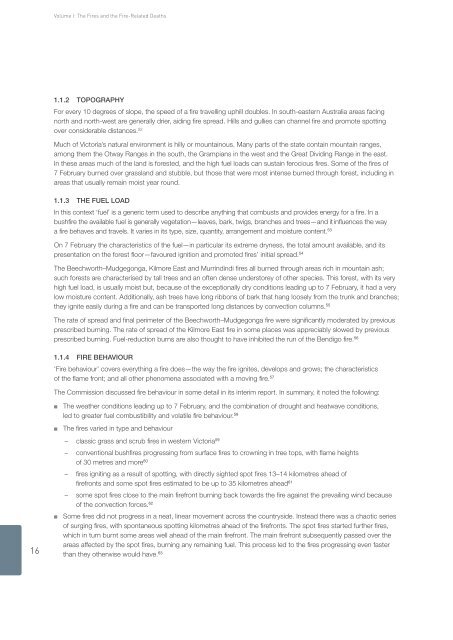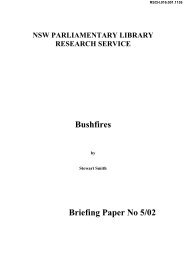1 CONDITIONS ON 7 FEBRUARY - 2009 Victorian Bushfires Royal ...
1 CONDITIONS ON 7 FEBRUARY - 2009 Victorian Bushfires Royal ...
1 CONDITIONS ON 7 FEBRUARY - 2009 Victorian Bushfires Royal ...
Create successful ePaper yourself
Turn your PDF publications into a flip-book with our unique Google optimized e-Paper software.
Volume I: The Fires and the Fire-Related Deaths<br />
1.1.2<br />
Topography<br />
For every 10 degrees of slope, the speed of a fire travelling uphill doubles. In south-eastern Australia areas facing<br />
north and north-west are generally drier, aiding fire spread. Hills and gullies can channel fire and promote spotting<br />
over considerable distances. 52<br />
Much of Victoria’s natural environment is hilly or mountainous. Many parts of the state contain mountain ranges,<br />
among them the Otway Ranges in the south, the Grampians in the west and the Great Dividing Range in the east.<br />
In these areas much of the land is forested, and the high fuel loads can sustain ferocious fires. Some of the fires of<br />
7 February burned over grassland and stubble, but those that were most intense burned through forest, including in<br />
areas that usually remain moist year round.<br />
1.1.3<br />
The fuel Load<br />
In this context ‘fuel’ is a generic term used to describe anything that combusts and provides energy for a fire. In a<br />
bushfire the available fuel is generally vegetation—leaves, bark, twigs, branches and trees—and it influences the way<br />
a fire behaves and travels. It varies in its type, size, quantity, arrangement and moisture content. 53<br />
On 7 February the characteristics of the fuel—in particular its extreme dryness, the total amount available, and its<br />
presentation on the forest floor—favoured ignition and promoted fires’ initial spread. 54<br />
The Beechworth–Mudgegonga, Kilmore East and Murrindindi fires all burned through areas rich in mountain ash;<br />
such forests are characterised by tall trees and an often dense understorey of other species. This forest, with its very<br />
high fuel load, is usually moist but, because of the exceptionally dry conditions leading up to 7 February, it had a very<br />
low moisture content. Additionally, ash trees have long ribbons of bark that hang loosely from the trunk and branches;<br />
they ignite easily during a fire and can be transported long distances by convection columns. 55<br />
The rate of spread and final perimeter of the Beechworth–Mudgegonga fire were significantly moderated by previous<br />
prescribed burning. The rate of spread of the Kilmore East fire in some places was appreciably slowed by previous<br />
prescribed burning. Fuel-reduction burns are also thought to have inhibited the run of the Bendigo fire. 56<br />
1.1.4<br />
Fire behaviour<br />
‘Fire behaviour’ covers everything a fire does—the way the fire ignites, develops and grows; the characteristics<br />
of the flame front; and all other phenomena associated with a moving fire. 57<br />
The Commission discussed fire behaviour in some detail in its interim report. In summary, it noted the following:<br />
16<br />
■■<br />
■■<br />
■■<br />
The weather conditions leading up to 7 February, and the combination of drought and heatwave conditions,<br />
led to greater fuel combustibility and volatile fire behaviour. 58<br />
The fires varied in type and behaviour<br />
59<br />
––<br />
classic grass and scrub fires in western Victoria<br />
––<br />
––<br />
––<br />
conventional bushfires progressing from surface fires to crowning in tree tops, with flame heights<br />
of 30 metres and more 60<br />
fires igniting as a result of spotting, with directly sighted spot fires 13–14 kilometres ahead of<br />
firefronts and some spot fires estimated to be up to 35 kilometres ahead 61<br />
some spot fires close to the main firefront burning back towards the fire against the prevailing wind because<br />
of the convection forces. 62<br />
Some fires did not progress in a neat, linear movement across the countryside. Instead there was a chaotic series<br />
of surging fires, with spontaneous spotting kilometres ahead of the firefronts. The spot fires started further fires,<br />
which in turn burnt some areas well ahead of the main firefront. The main firefront subsequently passed over the<br />
areas affected by the spot fires, burning any remaining fuel. This process led to the fires progressing even faster<br />
than they otherwise would have. 63
















